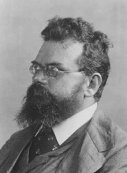| VIAS Encyclopedia provides a collection of tables and definitions commonly needed in science and engineering. |

|

Home  Science History Science History  Biographies Biographies  Ludwig Boltzmann Ludwig Boltzmann |
||||
| See also: Max Planck | ||||






|
||||
Ludwig Boltzmann
Ludwig Boltzmann was born in Vienna as the first son of the "Emperor and King's" Commissar of the Administration of Finances, Ludwig Georg Boltzmann and his wife, Maria Katharina (maiden name, Pauernfeind, from a Salzburg commercial family). After private instruction, he arrived at the Linz Academic High School in 1855, where he graduated in 1863 with honors. Afterwards, he moved to Vienna and started studying mathematics and physics. At the Institute of Josef Stefan, he wrote two scientific works during his studies (on the second fundamental theorem of the heat theory) and met Josef Loschmidt. In 1866, he earned a doctorate and in 1869, was appointed as a full professor of mathematical physics at the University of Graz. In 1870, he visited Bunsen and Kirchhoff in Heidelberg, and in 1872 he visited the Institute of Helmholtz in Berlin for a few months. Starting from 1874, he was a full professor of mathematics at the University of Vienna. In 1876, he married Henriette of Aigentler in Graz and some months later was invited to the Graz Physical Institute. Until 1890, he stayed in Graz as the Headmaster of the University and Dean of the philosophical faculty. Starting from 1890, he was responsible for theoretical physics in Munich. This time was the happiest in his academic career. Afterwards, he became the successor of Stefan in Vienna. He went to Leipzig in 1900 as a professor, however, in 1902, he returned again to Vienna. On different journeys in America, he had strained his health too much and his state of health had worsened. He was strongly short-sighted and required a woman to read for him. Asthma and headaches also became worse and he had to take time off. Also, two vacations near Triest brought him no relief, whereupon one day before the journey home, he took his own life. In the year 1865, he wrote his first work with contents about the movement of electricity. In this time, Rudolph Clausius originated the term "entropy". In 1872, Boltzmann related entropy to statistic measures. The majority of his work was focused on the second fundamental theorem of thermodynamics, which states that the condition of thermodynamic equilibrium is the most probable condition for closed systems. In 1877, Boltzmann showed that the entropy is a measure for the number of the realization possibilities of the macro condition: "It is therefore the measure of permutability (logarithm of the number of the microstates), a measure, which is identical to the entropy for the condition of the heat balance up to a constant factor and addendum: S=k logW". This formula is engraved in the gravestone of Boltzmann at his honorary grave at the Viennese Central Cemetery (Wiener Zentralfriedhof). Boltzmann was an exceptional experimenter. He proved this with experiments related to Maxwell's electrodynamics and electromagnetic theories. He took on each problem of his period, and wrote altogether 140 works. These also include a theory of the Hall Effect. Ludwig Boltzmann was a trailblazer for quantum mechanics and inspired Einstein for investigations about Brownian molecular movement. In addition, Erwin Schrödinger was inspired by Boltzmann's ideas: "His body of ideas plays for me the role of the scientific, high-school love, no other had so inspired me, no other probably ever will." He was a trailblazer in two different regards. He established the probability theory and discrete states of energy into the elementary laws of physics. He spoke in 1891 at a natural scientist meeting in Halle with Ostwald: "I see no reason, not to consider also the energy divided atomistically!" Planck was standing beside him at that time.
|
||||
Home  Science History Science History  Biographies Biographies  Ludwig Boltzmann Ludwig Boltzmann |
||||
Last Update: 2010-12-15


